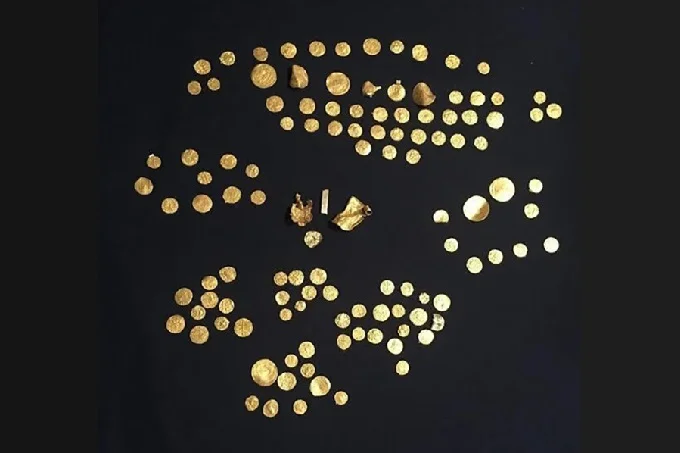The treasure of ancient gold coins, nicknamed the largest in the last three decades, was discovered in Norfolk, England. It was accidentally discovered by a man with a metal detector, who wished to remain anonymous.
At the time these coins were buried, England was not yet a single country. This treasure is more than 1400 years old. What secret hides this Anglo-Saxon cache and why scientists consider it so important, further in the review.
Norfolk cache
The West Norfolk cache contained 131 gold coins. Such a wealth of treasures made it the largest find of Anglo-Saxon artifacts ever found in England. Most of them are Frankish tremissis and a few gold solids. Solids are large denomination coins of the Byzantine Empire. The treasure also contained gold bars, a pendant, and two solid gold items that were once part of jewelry.
An anonymous metal detector discovered the treasure by accident and immediately notified the appropriate authorities. Unfortunately, scientists say that some of the stashes were looted. For example, a dozen gold pieces were found by a local detective, David Cockle. He even tried to sell them. As a result, he was captured, convicted, and sentenced to prison for a year and a half. Experts are going to recognize the find as a treasure of international importance. The treasure is planned to be acquired by Norwich Castle.
The 1996 law governs the recognition of the treasure trove in question. Tim Pestell, Senior Curator of Archaeology at Norwich Castle Museum and Art Gallery, says: “This globally significant find reflects the wealth and continental connections possessed by the early Kingdom of East Anglia. The study of the hoard and where it was found may reveal our understanding of early systems of trade and exchange. Also, the cache of coins demonstrates the great importance of West Norfolk to the ruling kings of East Anglia in the seventh century.”
The total amount of gold found in the Norfolk field exceeds by far the famous find at Sutton Hoo. Then, in 1939, during excavations, a purse was found with four dozen gold coins, three gold discs, and two gold ingots. The largest hoard of coins of the same period was a purse found in 1828 at Crondall in Hampshire. There were 101 coins.
Gareth Williams, a curator of early medieval coins at the British Museum, says: This is an extremely important find. It is very close in its dating to the famous Sutton Hoo hoard in Suffolk. The entire Suffolk treasure burial certainly contained more gold. Except that there are far more gold coins in Norfolk. In fact, this is the largest coin find of the period known to date.
The importance of this hoard is that, combined with other finds in East Anglia, it could help study the country’s history. It may fundamentally change the very understanding of the economic mechanism of the period of early Anglo-Saxon England.
“Man tests the proof of gold, and gold tests the proof of man.” These wise words were uttered five centuries ago by the English historian and preacher Thomas Fuller. All of human history speaks to the profound meaning of these words. People often go to terrible lengths for the sake of gold.
This treasure is no exception. It is impossible to ascertain the exact origin of the gold. What is clear is that the coins from this cache have been found at various times since 1991. Many of them are now in private collections. This is a great loss for historians.
At the time the West Norfolk hoard was buried, England was not yet a united country. It was divided into several smaller Anglo-Saxon kingdoms. Of these, the kingdom of the East Angles, including modern Norfolk and Suffolk, was one of the most important. The region was also one of the most productive in terms of finding archaeological artifacts. The last one is a striking confirmation of that.
It is incredibly significant for determining the wealth of the early kingdom and its continental connections. Researchers anticipate using this treasure to reveal a fuller understanding of early systems of trade and exchange. It suggests the extreme importance of West Norfolk to the kings of East Anglia in the 7th century. The stash is quite an interesting counterpart to Sutton Hoo at the other end of this kingdom.
Historians see the main task as protecting this valuable heritage from irresponsible collectors and antiquities dealers. After all, the coins from this cache have already partially disappeared among antiquities dealers. We cannot allow this to happen in the future. The recent discovery, according to experts, should help in the reconstruction of the earliest history of England.
The treasure
The Norfolk Coroner has launched an investigation to determine whether the finds are treasures under the provisions of the Treasure Act of 1996. Under it, any finds made by citizens are considered treasures only if they are more than three hundred years old, are made of gold or silver, or are found with artifacts containing precious materials. When such recognition is officially made, the treasure will become the property of the state. Then it will be turned over to the authorities for display in national or local museums.
According to the law, there are often cases when such finds, especially during the Roman domination, do not become a treasure. The fact is that, for the most part, these are objects made of bronze, and not of precious metals. In accordance with the law, items of national importance are often lost to history. They are sold to private collections and are never made available to the public again.
Such findings for the knowledge of history are priceless. Often these are not just coins, ingots, or jewelry, but rather exotic things.
